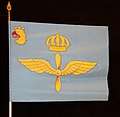Scania Air Force Wing
Scania Air Force Wing (Swedish: Skånska flygflottiljen), also F 10 Ängelholm, or simply F 10, is a former Swedish Air Force wing with the main base located in southernmost Sweden.
| Scania Air Force Wing | |
|---|---|
| Skånska flygflottiljen | |
 | |
| Active | 1940–2002 |
| Country | Sweden |
| Allegiance | Swedish Armed Forces |
| Branch | Swedish Air Force |
| Type | Wing (1940–1957) Sector wing (1957–1994) Wing (1994–2002) |
| Role | Fighter (1940–1993) Fighter/Reconnaissance (1993–1999) Multi (1999–2002) |
| Part of | Third Air Group (1944–1948) Second Air Group (1948–1966) Milo S (1966–2000) OPIL (2000–2002) |
| Garrison/HQ | Ängelholm |
| March | "Internationell gemenskap" (Ottervik)[note 1] |
| Insignia | |
| Roundels |   |
| Aircraft flown | |
| Attack | AJS 37 |
| Bomber | B 4, B 5, B 17 |
| Fighter | J 8, J 20, J 22, J 21R, J 29, J 34, J 35 |
| Multirole helicopter | Hkp 3B |
| Reconnaissance | AJSF 37, AJSH 37 |
| Trainer | Sk 11, Sk 12, Sk 14, Sk 15, Sk 16, Sk 25, Sk 50, Sk 60 |
| G 101, Se 102, Se 103, Se 104, JAS 39A/B | |
History
The tenth air force wing initially started as a detachment located at Svea Air Force Wing (F 8) during the summer of 1940 but was relocated to Bulltofta Airport near Malmö on October 1, 1940 to deter foreign aircraft during the war. The first aircraft were two squadrons of older J 8's from Svea Air Force Wing (F 8) wing which served for only one year until they were replaced by three squadrons of the J 20's.
In 1941, it was decided to transfer the wing to a new base at Barkåkra near Ängelholm. In 1945 the wing was completely transferred and equipped with J 22 fighters. However, the grass field was too soft and full flight operations could not be undertaken until 1947 when one runway was paved.
In 1949 the squadrons replaced the J 22s with J 21R jets which only served two years until being replaced by J 28B in 1951. These also only served for two years until in turn being replaced by the J 29 which served until 1963.
While waiting for the new J 35, two of the squadrons replaced their J 29s with J 34 from Södertörn Air Force Wing (F 18) until the wing was fully converted in 1969. The J 35 served F 10 for a total of 34 years across several upgrades until they were replaced initially by the AJS 37 in one squadron in 1993 and then the JAS 39 in the two remaining squadrons in 1999.
In 1996, the duty of basic flying training for the Swedish Air Force was transferred from the Swedish Air Force Flying School (F 5) to F 10 together with one squadron of SK 60 trainers.
The wing was decommissioned on December 31, 2002 as a result of the disarmament policies set forward in the Defence Act of 2000. The two squadrons of JAS 39 were transferred to Blekinge Air Force Wing (F 17) and the flight school along with their SK 60 squadron was transferred to Uppland Air Force Wing (F 16).
The premises are currently owned by the construction company PEAB. Koenigsegg Automotive has their factories and office located in former F 10 buildings. The F 10 first squadron's 'ghost' is also placed on all Koenigsegg cars. The flight museum of Ängelholm is also located on the premises.
Barracks and training areas
The civilian airfield Bulltofta in Malmö during the years 1940-1945 and the airfields in Rinkaby, Ripa and Sövdeborg. The wing moved between 10 September and 27 October 1945 to Barkåkra (Engeltofta estate) outside Ängelholm.[2]
- Aerial view
 Hospital building
Hospital building Former hangar
Former hangar Monument at Bulltofta
Monument at Bulltofta
Heraldry and traditions
Coat of arms
The first coat of arms of the Scania Air Force Wing was used from 1940 to 1994. Blazon: "Or, the provincial badge of Scania, an erazed head of a griffin gules with open crown and arms azure."[3] The second coat of arms was used from 1994 to 2002. Blazon: "Or, the provincial badge of Scania, an erazed head of a griffin gules, with open crown and arms azure, a chief azure charged with a winged twobladed propeller or.[3]
 Coat of arms used from 1940 to 1994.
Coat of arms used from 1940 to 1994. Coat of arms used from 1994 to 2002.
Coat of arms used from 1994 to 2002.
Colours, standards and guidons
The colour was presented to the wing at F 8 Barkarby by His Majesty the King Gustaf V on 17 September 1943.[4] It was handed over to Blekinge Air Force Wing (F 17) as a traditional colour when F 10 was disbanded on 31 December 2002. The colour is drawn by Brita Grep and embroidered by hand in insertion technique by the company Libraria. Blazon: "On blue cloth in the centre the badge of the Air Force; a winged two-bladed propeller under a royal crown proper, all in yellow. In the first corner the provincial badge of Skåne; an erazed yellow head of a griffin with an open crown, armed red."[4]
From 1998 to 2002, the wing also carried the colour of the former Swedish Air Force Flying School (F 5).[5]
 The 1943 colour.
The 1943 colour.
March
"Internationell gemenskap" was composed by chief librarian Gösta Ottervik. It was established on 9 September 1980.[6]
Commanding officers
Commanding officers from 1940 to 2002.[2] From 1940 to 1974, the commanding officers was referred to as flottiljchef ("wing commander") and had the rank of lieutenant colonel for the first two years. From 1942, the commanding officer had the rank of colonel. From 1974 to 1994, the wing commander was referred to as sektorflottiljchef ("sector wing commander") and had the rank of colonel 1st class. From 1994 to 2002, the commanding officer was again referred to as flottiljchef ("wing commander"), and had the rank of colonel.
Corps, wing and sector wing commanders
- 1940–1946: Knut Zachrisson
- 1946–1956: Bill Bergman
- 1956–1960: Wilhelm Wagner
- 1960–1962: Claes Henrik Nordenskiöld
- 1962–1966: Ian Iacobi
- 1966–1969: Kjell Rasmusson
- 1969–1979: Ulf Cappelen-Smith
- 1979–1985: Anders Sjöberg
- 1985–1987: Bertil Bjäre
- 1987–1992: Rolf Clementson
- 1993–1994: Mats Hugosson
- 1994–1994: Mats Hellstrand
- 1995–1999: Kjell Öfverberg
- 1999–2001: Tomas Fjellner
- 2001–2002: Hans Hansson
Deputy sector wing commanders
In order to relieve the sector wing commander, a deputy sector wing commander position was added in 1974. Its task was to lead the unit procurement, a task largely similar to the old wing commander position. Hence he was also referred to as flottiljchef ("wing commander"). The deputy sector wing commander had the rank of colonel. On 30 June 1994, the deputy sector wing commander position was terminated.
- 1974–1980: Bertil Bjäre
- 1980–1985: Sten Norrmo
- 1985–1987: Gunnar Ståhl
- 1987–1989: Sten Öhlander
- 1989–1991: Göte Pudas
- 1991–1993: Mats Hugosson
Names, designations and locations
| Name | Translation | From | To | |
|---|---|---|---|---|
| Wendes flygflottilj | Wendes Air Force Wing | xxxx-xx-xx | – | xxxx-xx-xx |
| Tionde flygflottiljen | 10th Air Force Wing | 1940-10-01 | – | 1942-06-30 |
| Kungl. Skånska flygflottiljen | Royal Scania Air Force Wing | 1942-07-01 | – | 1974-12-31 |
| Skånska flygflottiljen | Scania Air Force Wing | 1975-01-01 | – | 2002-12-31 |
| Avvecklingsorganisation Ängelholm | Decommissioning Organization Ängelholm | 2003-01-01 | – | 2003-12-31 |
| Designation | From | To | ||
| F 10 | 1940-07-01 | – | 1957-09-30 | |
| F 10/Se S1 | 1957-10-01 | – | 1981-06-30 | |
| F 10/Se S | 1981-07-01 | – | 1993-06-30 | |
| F 10/FK S | 1993-07-01 | – | 1994-06-30 | |
| F 10 | 1994-07-01 | – | 2002-12-31 | |
| Ao Äng | 2003-01-01 | – | 2003-12-31 | |
| Location | From | To | ||
| Ängelholm Airport | 1945-10-01 | – | 2003-12-31 |
See also
Footnotes
- The march was established on 9 September 1980.[1]
References
Notes
- Sandberg 2007, p. 58
- Braunstein 2005, p. 81
- Braunstein 2006, pp. 59-60
- Braunstein 2004, p. 71
- Braunstein 2005, p. 79
- Braunstein 2005, p. 80
Print
- Braunstein, Christian (2004). Svenska försvarsmaktens fälttecken efter millennieskiftet [The flags and standards of the Swedish armed forces after the turn of the millennium] (PDF). Skrift / Statens försvarshistoriska museer, 1101-7023 ; 7 [dvs 8] (in Swedish). Stockholm: Statens försvarshistoriska museer. ISBN 91-971584-7-X. SELIBR 9815350.CS1 maint: ref=harv (link)
- Braunstein, Christian (2005). Svenska flygvapnets förband och skolor under 1900-talet (PDF). Skrift / Statens försvarshistoriska museer, 1101-7023 ; 8 [dvs 9] (in Swedish). Stockholm: Statens försvarshistoriska museer. ISBN 9197158488. SELIBR 9845891.
- Braunstein, Christian (2006). Heraldiska vapen inom det svenska försvaret [Heraldry of the Swedish Armed Forces] (PDF). Skrift / Statens försvarshistoriska museer, 1101-7023 ; 9 (in Swedish). Stockholm: Statens försvarshistoriska museer. ISBN 91-971584-9-6. SELIBR 10099224.CS1 maint: ref=harv (link)
- Sandberg, Bo (2007). Försvarets marscher och signaler förr och nu: marscher antagna av svenska militära förband, skolor och staber samt igenkännings-, tjänstgörings- och exercissignaler (in Swedish) (New ed.). Stockholm: Militärmusiksamfundet med Svenskt marscharkiv. ISBN 978-91-631-8699-8. SELIBR 10413065.CS1 maint: ref=harv (link)
Further reading
- Fjellner, Tomas; Ohlsson, Ulf; Hansson, Kenneth (2003). Flygvapen över Skåne: F 10 minnesbok : [Skånska flygflottiljen 1940-2002] (in Swedish). Ängelholm: Kenneth Hansson, Avvecklingsorganisationen Ängelholm/Försvarsmakten. ISBN 9163139197. SELIBR 9022249.
- Forsberg, Sigvard, ed. (1990). Skånska flygflottiljen 50 år: 1940-1990 (in Swedish). Ängelholm: Skånska flygflottiljen. ISBN 9179709125. SELIBR 7678611.
- Stridsberg, Sven (1985). Tionde flygflottiljen på Bulltofta 1940-1945 (in Swedish). Harlösa: S. Stridsberg. ISBN 9178103819. SELIBR 7666896.
External links
| Wikimedia Commons has media related to F 10 Ängelholm. |